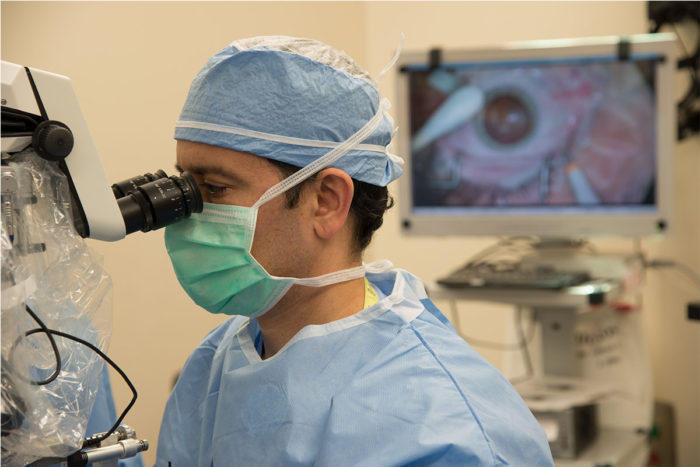Same immune cell missteps occur in high cholesterol and macular degeneration
New research raises the intriguing possibility that drugs prescribed to lower cholesterol may be effective against age-related macular degeneration

Rajendra Apte, MD, PhD, performing eye surgery.
New research, led by Rajendra Apte, MD, PhD, a Washington University retina specialist at Barnes-Jewish Hospital, sheds new light on the cause of cholesterol buildup known to contribute to macular degeneration. Working in mice and in human cells, the investigators linked the buildup to a specific malfunction in immune cells called macrophages. This malfunction is already being targeted by some drugs currently in use as high cholesterol treatments.
“Based on our findings, we believe it would be worthwhile to investigate whether vision loss caused by macular degeneration might be prevented with cholesterol-lowering eye drops or other medications to prevent the buildup of lipids beneath the retina,” said Apte.
The new research continues Apte’s focus on the role of macrophages in retinal disease. One task that those immune cells can perform involves the removal of cholesterol and fats from tissues, including the eye. In macular degeneration, the excessive buildup of cholesterol begins to occur in the eye as we age, and macrophages can begin to malfunction.
Fat deposits in the eye
In the “dry” form of age-related macular degeneration, it’s possible for doctors examining the eye to identify fat deposits beneath the retina. As those deposits become larger and more numerous, they slowly begin to destroy the central part of the eye, interfering with vision.
The cycle of disease progresses as aging macrophages clear fewer fat deposits beneath the retina, and the macrophage cells themselves can become bloated with cholesterol, creating an inflammatory process that leads to the formation of new blood vessels that can cause further damage. Those vessels characterize the later “wet” form of the disease.
“Ultimately, that inflammatory process creates a toxic mix that leads to new blood vessel growth,” Apte explains.
In his current study, Apte, the Paul A. Cibis Distinguished Professor of Ophthalmology and Visual Sciences, and his team found that macrophages, from old mice and in patients with macular degeneration, have inadequate levels of the protein ABCA1, which transports cholesterol out of cells. As a result, the old macrophages accumulated high levels of cholesterol and couldn’t inhibit the growth of damaging blood vessels that characterize the “wet” form of the disorder.
But when the researchers treated the macrophages with a substance that helped restore levels of ABCA1, the cells could remove cholesterol more effectively, and the development of new blood vessels was slowed.
“We have shown that we can reverse the disease cascade in mice by improving macrophage function,” Apte said. “Some of the therapies already being used to treat high cholesterol target this same pathway, so we may be able to modify drugs that already are available and use them to deliver treatment to the eye.”







